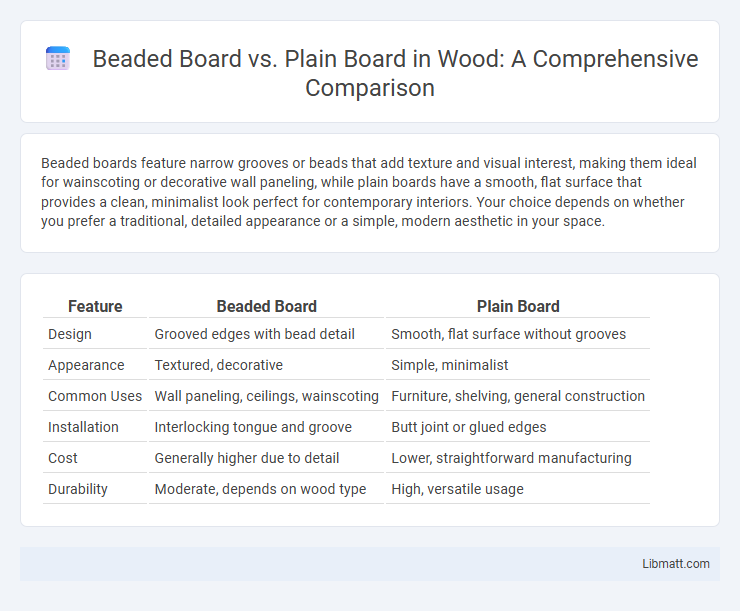Beaded boards feature narrow grooves or beads that add texture and visual interest, making them ideal for wainscoting or decorative wall paneling, while plain boards have a smooth, flat surface that provides a clean, minimalist look perfect for contemporary interiors. Your choice depends on whether you prefer a traditional, detailed appearance or a simple, modern aesthetic in your space.
Table of Comparison
| Feature | Beaded Board | Plain Board |
|---|---|---|
| Design | Grooved edges with bead detail | Smooth, flat surface without grooves |
| Appearance | Textured, decorative | Simple, minimalist |
| Common Uses | Wall paneling, ceilings, wainscoting | Furniture, shelving, general construction |
| Installation | Interlocking tongue and groove | Butt joint or glued edges |
| Cost | Generally higher due to detail | Lower, straightforward manufacturing |
| Durability | Moderate, depends on wood type | High, versatile usage |
Introduction to Beaded Board vs Plain Board
Beaded board features narrow, evenly spaced grooves that add texture and visual interest, making it a popular choice for wainscoting, ceilings, and accent walls. Plain board offers a smooth, flat surface ideal for minimalist designs or areas where a clean, uninterrupted look is desired. Understanding the differences between beaded and plain boards helps you select the best option to enhance your interior decor and achieve your desired aesthetic.
Understanding Beaded Board: Features and Styles
Beaded board features narrow wooden planks with a distinctive small groove or "bead" between each board, adding texture and visual interest to walls or ceilings. This style often comes in various panel widths and finishes, offering a classic, cottage, or farmhouse aesthetic while providing durability and ease of installation. Your choice of beaded board can enhance interior spaces with a timeless, detailed look that plain boards lack.
What is Plain Board? Characteristics and Applications
Plain board is a flat, smooth panel typically made from MDF, plywood, or solid wood, characterized by its uniform surface without grooves or decorative lines. Its simplicity and versatility make it ideal for applications such as cabinetry, wall paneling, furniture, and shelving where a clean, minimalist aesthetic is desired. Plain board is preferred in modern and contemporary designs, offering a neutral backdrop that can be painted, stained, or finished to suit a variety of interior styles.
Visual Appeal: Beaded vs Plain Board Designs
Beaded boards feature evenly spaced grooves that create a visually textured pattern, lending a classic, cottage-style charm to interiors and exteriors. Plain boards offer a smooth, clean surface that provides a minimalist, modern aesthetic ideal for sleek, contemporary spaces. The choice between beaded and plain board designs significantly impacts the visual character, with beaded boards adding dimension and detail, while plain boards emphasize simplicity and uniformity.
Installation Process: Beaded Board vs Plain Board
Beaded board features pre-formed grooves that allow for straightforward alignment and interlocking during installation, reducing the need for precise cutting. Plain board requires more careful measuring and cutting to ensure tight seams and smooth finishes, often demanding additional tools or trim to cover gaps. The tongue-and-groove system of beaded board simplifies the process, making it more accessible for DIY projects compared to the labor-intensive fitting of plain boards.
Durability and Maintenance Comparison
Beaded board features grooves that can trap dust and require more frequent cleaning, while plain board's smooth surface allows for easier maintenance and quick wiping. In terms of durability, both materials typically use similar wood types, but plain board resists wear better over time due to the absence of grooves that can chip or crack. To maintain the look and lifespan of your wall, plain board offers a practical solution with lower upkeep.
Cost Differences: Beaded Board vs Plain Board
Beaded board generally costs more than plain board due to its decorative grooves and detailed craftsmanship, which require additional manufacturing steps. Plain board offers a more budget-friendly option while providing a smooth, simple surface ideal for versatile applications. Your choice between beaded and plain board should consider the balance between aesthetic appeal and cost efficiency for your specific project.
Best Uses in Home Décor and Renovation
Beaded board enhances home decor and renovation projects by adding textured, vintage charm, making it ideal for wainscoting, ceilings, and accent walls in cottages, bathrooms, and kitchens. Plain board provides a smooth, versatile surface suited for modern, minimalist designs, perfect for cabinetry, furniture, and wall paneling where a clean, seamless look is desired. Choosing between beaded and plain board depends on whether the design calls for decorative detailing or understated simplicity.
Pros and Cons of Beaded and Plain Boards
Beaded boards offer a classic, decorative appearance with distinct vertical grooves that enhance texture and charm, making them ideal for wainscoting and cottage-style interiors, but they can be more difficult to clean and install compared to plain boards. Plain boards provide a smooth, versatile surface that is easier to paint, clean, and maintain for modern or minimalist designs, yet they may lack the visual interest and depth found in beaded boards. Choosing between beaded and plain boards depends on aesthetic preference, maintenance level, and the desired architectural detail for the space.
How to Choose: Beaded Board or Plain Board?
When choosing between beaded board and plain board, consider the room's style and desired texture; beaded board offers a classic, decorative look with vertical grooves ideal for cottage or farmhouse designs, while plain board provides a smooth, minimalist surface suitable for modern or contemporary spaces. Also evaluate installation complexity and maintenance--beaded boards may require more precise alignment and cleaning due to grooves, whereas plain boards are easier to paint and maintain. Budget and material type, such as wood or MDF, influence durability and cost, so select based on functional needs and aesthetic preference.
Beaded board vs Plain board Infographic

 libmatt.com
libmatt.com